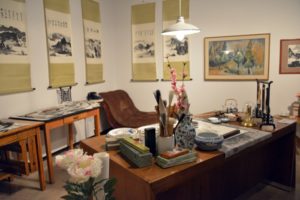Some artists, no matter how talented they are, will end up forgotten. But rediscovering them can yield some incredible artwork and history. Montreal’s Karen Tam recently learned of a Chinese artist who was friends with Emily Carr; Tam has now put together an exhibit to honour that artist—Lee Nam—and his work.
“We only know about him because of mentions of him through [Carr’s] journals,” says Tam. “She had several entries where she described meeting him and where he did his work. I used her descriptions as a starting point to think and look about immigrate artists in Canada. I collaborated with another Montreal-based artist who does Chinese brush art to reimagine Nam’s work, as well as his own experiences with Canada’s landscape and how he painted it.”

Tam, intrigued by Nam, decided to dig further into his work as well as his connection with Carr. Tam found herself at the UVic archives looking for any link between the two that she could find. Eventually, Tam found what she was looking for—a piece of art—and has used it in her exhibit.
“It’s an image of a group of chickens,” she says. “I asked my mother, as well as other collaborators, to help paint some sketches. We have about 300 sketches of birds, some of which are chickens. We then linked that to the exhibit by having a video that shows how to paint these chickens. Then viewers can go try their hand at painting chickens in the style of Lee Nam.”
But Tam’s platoon of bird sketches won’t be the only thing on display at the art gallery. She says that she’s expanded the exhibit to be inclusive, as Carr was toward Nam when they first met.
“I’ve also welcomed a few local artists in the community to include one or two of their paintings alongside other Chinese paintings,” says Tam. “Also on display are some of Emily Carr’s paintings. In one of her journal entries she explained how she traded paintings with Lee Nam. I thought that was quite interesting because if Nam had returned to China, maybe there are one or two Emily Carrs that we don’t know about that are in China.”
Tam’s original goal was to focus on and bring awareness to Nam. After researching Nam, Tam realized that there is so much more to get out of his work.
“I think there are a lot of points where people can connect with, either through Chinese art or Emily Carr,” says Tam. “I also wanted to look at if immigrant artists were being included in Canadian art history, but that turned back into itself, and I thought that they may not be in Chinese art history either. I hope that people take away a more mindful sense of inclusion and what could’ve possibly been left out.”
Tam says that although she had a lot of time to research Nam, it turned out to be quite difficult.
“We discovered that he spelled his name two different ways, which made things a lot harder,” says Tam. “In addition, I also looked at federal immigration records, which weren’t complete. We don’t even know how he wrote his name in Chinese—Lee Nam might’ve been his pen name. It’s frustrating but also opens up a lot to the imagination.”

